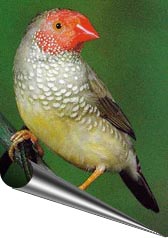|
|
|
 |
Custom Layout 2 |  |
|
SPECIES OF AUSTRALIAN FINCHES. |
||
 Your custom image |
||
|
CRIMSON FINCH (NEOCHMIA PHAETON) A very attractive bird and saddly very rare and even if found, very expensive, The cock is most striking with brown on top of the head and on the back down to the rump and bright crimson on the cheeks, throat, chest and sides of the belly, the latter flecked with white spots. The centre of the belly and under-tail coverts are black, the rump and tail crimson. The wings are brown with dull crimson edges to the feathers. The beak is red. Easily sexed, the hen is ashy grey instead of brown and has light brown on the chest and belly instead of crimson. There is a sub-species in which the black of the middle belly and under-tail coverts is replaced with light whitish brown. This species is not one to take up lightly, it can be extremly aggressive to other birds and to its own species, and cocks can become aggresive to other birds and to its own partner. for nesting a larger than average nestbox is required with plenty of coconut fibre, The crimson usually have a clutch of between 5 to 8 eggs, and again unusually do not brood their chicks tight but only once the chicks are 10 days old. fledging occurs around 20 to 30 days old and the young do not return to the nest after fledging. This species is a real challenge to even the most experience breeder with plenty of time to look after them. |
||
| DIAMOND SPARROW
a justly popular bird known to most keepers. The colouation is striking with a red beak, grey top of the head and nape, white cheeks and throat, black eye streak, brown on the back and wings, a wide black band on the white belly and black edges speckled with white, white on the under-tail area and crimson on the rump, the tail crimson for the top half and black at the end. Sexing is dificult, the hen can be smaller and have a narrower black band on the chest but although the hen also calls only the cock has the call of a long stretch of low rasping notes. The books often say that the diamond sparrow is a poor cage bird and should be bred in flights, especially as the cocks can be aggresive towards other birds and towards each other; like some other birds, pairs vary and some are profilic breeders where others are reluctant. they can rear their young on seed alone but some livefood should be offered. the normal finch nest box is used with the usual nesting material. This species needs more care in pairing up and it is best to have several birds and let them choose their own partners. |
||
|
Your custom image |
||